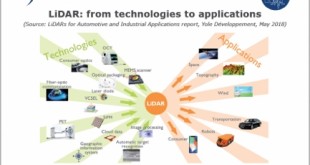Innovations in CMOS image sensor (CIS) technology continue to enhance digital imaging landscape. While the demand has been driven by smartphone makers, leveraging enhanced photo-taking capabilities to differentiate their devices from the competition, there is also a growing market for applications in the automotive, security, medical, and manufacturing sectors. Smartphone camera …
Read More »DARPA IP2 seeks In Pixel Intelligent Processing tech
The AIE program is one key element of DARPA’s broader AI investment strategy that will help ensure the U.S. maintains a technological advantage in this critical area. Past DARPA AI investments facilitated the advancement of “first wave” (rule based) and “second wave” (statistical learning based) AI technologies. DARPA-funded R&D enabled …
Read More »Novel LIDARs for 3D mapping, Driverless vehicles, Battlefield Visualization, Mine Hunting, and Imaging through forests
Remote sensing means that we aren’t actually physically measuring things with our hands. We are using sensors that capture information about a landscape and record things that we can use to estimate conditions and characteristics. LiDAR, or light detection ranging (sometimes also referred to as active laser scanning) is one …
Read More »Visible light Communications or LiFi for, Internet of Things, 5G mobile, Military Vehicular and Underwater networks
It is predicted that LEDs will be the ultimate light source in the near future powering indoor illumination, outdoor lamps, traffic signs, advertising displays, car headlights/taillights, etc. Now another technique promises to double the utility of light-emitting diodes (LEDs) by using their light as a medium for communication in a …
Read More »DARPA GRYPHON developing high-performance microwave frequency source based on integrated photonics
In our information society, the synthesis, distribution, and processing of radio and microwave signals are ubiquitous in wireless networks, telecommunications, and radars. The current tendency is to use carriers in higher frequency bands, especially with looming bandwidth bottlenecks due to demands for e.g. 5G and the “Internet of Things.” “Microwave …
Read More »Ion Mobility Spectrometry and Its Applications in Detection of Chemical Warfare Agents
The threat of weapons of mass destruction (WMDs), such as chemical warfare agents (CWAs) and toxic industrial chemicals, is of great concern worldwide. This menace makes it necessary to detect the presence of such weapons in both military and civil environs. Toxic chemicals are used in large quantities by industry, …
Read More »Laser Technology Market
Laser, a device that stimulates atoms or molecules to emit light at particular wavelengths and amplifies that light, typically producing a very narrow beam of radiation. The emission generally covers an extremely limited range of visible, infrared, or ultraviolet wavelengths. Many different types of lasers have been developed, with highly …
Read More »Non-Line-of-Sight Imaging can be transformative in medicine, robotics, manufacturing, and security
We see things because our eyes are sophisticated light detectors: they constantly capture the light rays bouncing off nearby objects so our brain can construct an ever-changing impression of the world around us. Similarly in a camera, All the light traveling from the object enters a single lens before it …
Read More »Twisted light can provide 100-times faster fiber capacity and secure wireless data transmission to moving platforms like UAVs
Broadband fiber-optics carry information on pulses of light, at the speed of light, through optical fibers. But the way the light is encoded at one end and processed at the other affects data speeds. Basically, light or any other electromagnetic radiation has energy defined by its frequency and momentum defined by …
Read More »Twisted light technology
Space-division multiplexing (SDM) has recently attracted great attention as a promising technology to further improve the transmission capacity and spectral efficiency. Very recently, SDM employing twisted lights, also known as orbital angular momentum (OAM) carrying lights, provides an alternative approach to increasing the transmission capacity and spectral efficiency of optical communications. …
Read More » International Defense Security & Technology Your trusted Source for News, Research and Analysis
International Defense Security & Technology Your trusted Source for News, Research and Analysis









